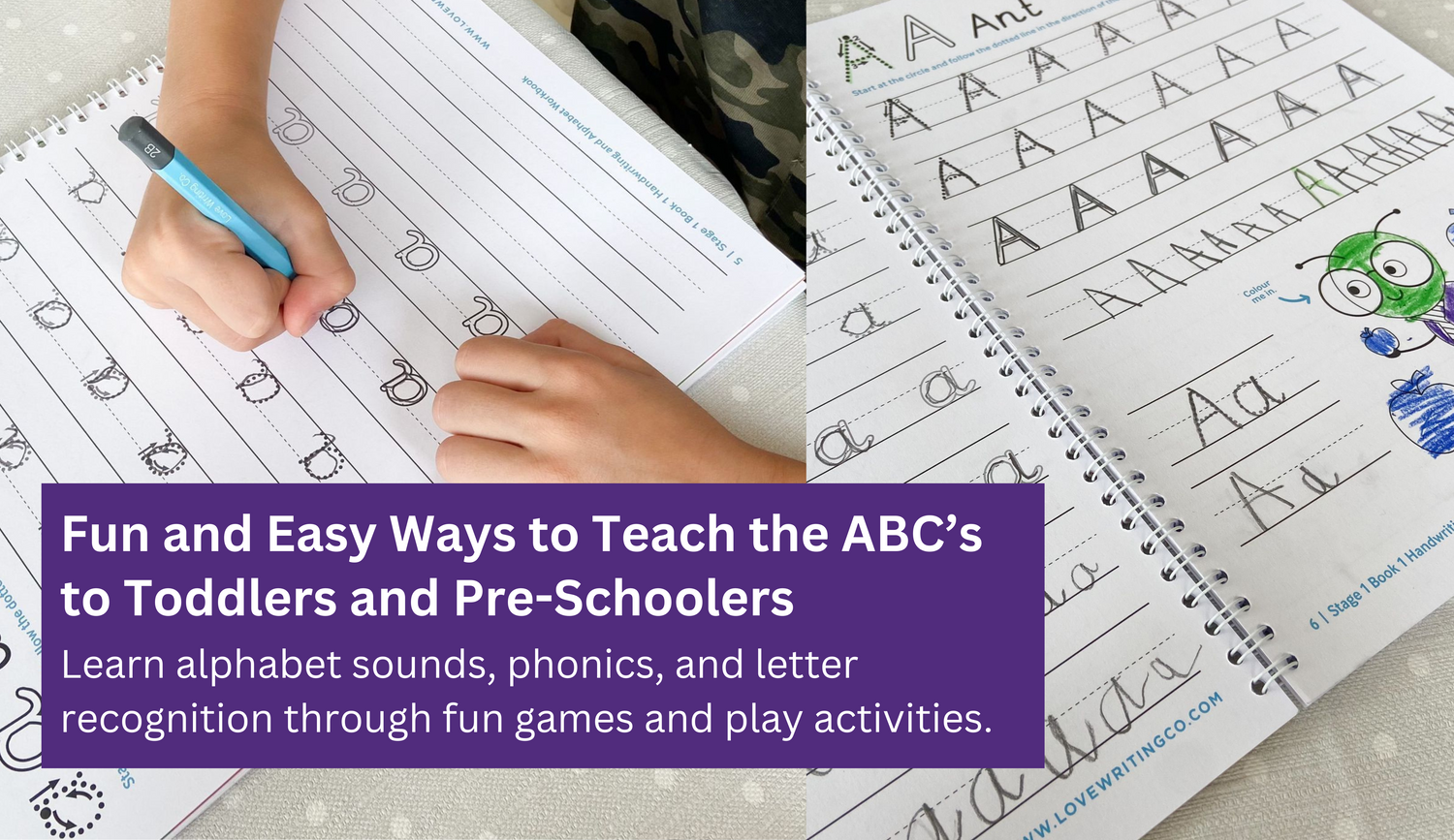Learn Alphabet Sounds, Phonics and Letter Recognition Through Fun Games and Play Activities
Is your little one ready to start learning letters of the Alphabet?...
Teaching the alphabet is the foundation for kids to learn new letters, words and sounds as they explore the world around them. So, learning their ABCs is actually the first stepping stone to learning other new things like counting numbers one to ten or different shapes and colours. When a child can understand alphabet sounds and can recognize different letters it is helping to improve their memory retention skills.
For example, are they still saying ‘lellow’ instead of ‘yellow’? Alphabet sounds and phonics practice will help your child understand letters of the alphabet and pronounce them in the correct way.
Every parent knows that learning the alphabet is the perfect first step to helping your child become a confident and happy writer. But simply reciting ‘A, B, C…’ from memory can sometimes feel like a chore for little learners (and even for grown-ups!).
If you’re looking for creative, hands-on activities to make early learning fun and help those letters stick, you're in the right place! Whether you’re a parent or an early years teacher, these engaging ideas will turn ABC practice into an adventure your preschooler will love.
Why Make Learning the Alphabet Fun?
Young children learn through fun play, movement, music and exploration. Playful experiences capture their attention, keep motivation high and inspire a lifelong love of learning.
When you combine fun songs, games, and activities into teaching the alphabet, you’ll find your child is not just memorising letters but they are enthusiastic to learn more and challenge themselves further. Active engagement and having fun whilst learning helps children learn faster and remember what they've learned for longer.
Playful Strategies for Teaching ABCs
With so many different ways to play and learn, discovering what works for your child can be a learning adventure full of fun learning and educational exploration. Here are some tried-and-tested strategies to get you started:
Sing and dance along to the ABC song: The rhythm and melody make it easy to remember. Try adding actions for each letter, such as “jump for J” or “march for M”, to keep them moving and engaged.
Alphabet games: Try memory matching games with flashcards, or go on a letter scavenger hunt around the house or garden to find objects beginning with each letter.
Tactile letter fun: Let your child form letters out of playdough, pipe cleaners, or sand using sensory trays. This kind of hands-on activity makes learning stick and supports fine motor skills.
Storytime with a twist: Read books like those featuring big, bold alphabets. These are perfect for pointing out letter shapes and practicing sounds together.
Not every child learns in the same way, so mix and match activities to suit their interests and energy levels for the day.
All of our Handwriting Activity Books for 2, 3, 4 and 5 year olds include a guide for parents, teachers and children to learn how to hold their pencil with step-by-step directional arrows that teach them how to trace pre-cursive letters correctly. Being a lay-flat design and ring-binded, our workbooks are suitable for both right and left-handed children learning to write.
We believe that learning to write should be easy and accessible to all children so our special educational needs friendly educational resources are the perfect companion for any child embarking on their way to early learning success.
Help your child get ahead with classroom learning using our workbooks that complement the eyfs National Curriculum and become an ks1 early literacy and writing super star!


Creative ABC Activities for Fast Learning
You might be wondering, ‘How can I help my child learn the Alphabet fast?’’. Learning new things can feel less overwhelming when broken into manageable chunks. Even just 15 minutes of practice a day is the perfect amount to help your child build confidence and develop a positive attitude towards learning. Here are some great tips and ideas to try:
Alphabet puzzles: Putting together wooden or foam letter puzzles gives children the opportunity to recognise and handle each letter shape, helping them remember what’s what.
Letter tracing and colouring: Hands-on activities like lining letters with finger paint or tracing large letters help reinforce memory and introduce early writing skills. You could use printable alphabet letters to keep tracing fresh and exciting.
Sensory letter hunts: Hide foam or magnetic letters in a bowl of rice or sand, and let your preschooler hunt for their targeted ABCs.
Make writing tools irresistible: Choosing brightly coloured, easy-to-hold writing pencils or crayons can encourage even reluctant writers to give letters a go. Remember, small hands benefit from tools made just for them, supporting correct pencil grip and boosting confidence.
Take away the tears and frustrations of learning to write with Love Writing Co. Tripod Grip Writing Pencils, especially developed to fit a child’s hands and loved by little learners, parents and teachers.
Developed to be the correct length and with a wider diameter, softer core and break resistance, our pencils prevent muscle fatigue whilst encouraging the correct tripod grip from the very first use, promoting a love of writing from an early age.
✏️Wider diameter - easy to hold
✏️Softer core - break resistant and helps to apply less pressure
✏️Hexagonal shape - aids the correct dynamic tripod grip
✏️Correct length - writing pencils for 2, 3, 4 and 5 year olds
✏️Premium finish - simple to clean
✏️Linden wood - strong but light

Setting Up for Success: Little Tips That Make a Big Difference
Effective alphabet teaching isn’t just about repetition, it’s about creating small moments of success and fun every single day. Here are some top tips to incorporate ABC learning naturally into your family routine:
Consistency is key: A few minutes of play with letters every day is more effective (and less frustrating!) than long practice sessions.
Link letters to children’s names and interests: Children often learn fastest when there’s a personal connection. Start with the letters in your child’s name, or link ‘A’ to “animals” if they love animals.
Praise effort and celebrate milestones: Every time your child spots, says or writes a new letter, no matter how wobbly, celebrate their achievement. Positive reinforcement keeps motivation high.
Move from recognition to writing: Once your child is confidently identifying letters, introduce letter formation. Try fun, themed handwriting books that guide them through each step, keeping progress rewarding.
Making ABCs the Start of a Lifelong Writing Journey
Learning the alphabet can be a joyful, confidence-boosting journey when you make it active, playful and fun.
By turning everyday moments into opportunities to spot the letter, playing ‘I spy’ in the car or even having alphabet spaghetti for dinner, you boost not just their skills but encourage their love of learning itself. Every child learns at their own pace, so be patient, keep it fun, and don’t forget to celebrate the little wins along the way. With the right tools and encouragement, you’re not just teaching your child their ABCs—you’re building foundations for happy, stress-free learning and setting them up for success!
If you’re on the lookout for more fun activities or children's handwriting resources, take a look at our range of engaging alphabet practice books and activities for pre-schoolers, designed to make learning to write easy, enjoyable and full of smiles. Here’s to a brilliant start to your child’s learning to write adventure!
Happy Writing ❤️✏️
Shop Handwriting and Alphabet Practice Workbooks - Cursive and Pre-Cursive handwriting practice books for children that complement the UK National School Curriculum | SENDfriendly special educational needs resources for children | lay-flat format is ideal for right or left-handed handwriting practice
Shop Tripod Grip Writing Tools - Small, chunky, hexagonal fine motor tripod grip writing pencils. Designed to be the correct length for little hands and with a wider diameter, softer core and hexagonal shape, our pencils prevent muscle fatigue and encourage the correct tripod grip, promoting a love of writing from an early age.
Shop Instant Downloadable Activity Learning Workbooks - Perfect activity sheets and workbooks for fun learning at home, holidays and useful print on demand. Available for children ages 2-9






1 comment
Sudha Acadamey
Using interactive alphabet strategies, such as songs, scavenger hunts, and tactile activities, toddlers are able to develop phonics, fine motor skills, and fun at the same time.
Leave a comment
All comments are moderated before being published.
This site is protected by hCaptcha and the hCaptcha Privacy Policy and Terms of Service apply.